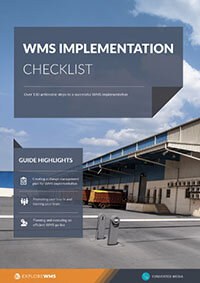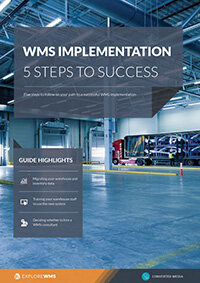WMS implementation guide including checklist & project plan
You've selected your perfect WMS, you're ready to reap the benefits of your system, but how?
Implementing a WMS is, unfortunately, the hard part.
You're in the right place though! We're here to walk you through how to make your WMS implementation move smoothly from start to finish. From change management planning, implementation costs from WMS training courses, and hidden data fees to the general increase in staff you might need to expect, we have you covered.
Together, we’ll share a WMS implementation checklist to ensure you’re prepared for things to launch. We can’t flip the switch for you, but we can make sure you’re ready with a WMS implementation project plan.
Here’s what you’ll get help with:
- Who to add to your WMS implementation team
- How change management can save you from unnecessary headaches
- Putting together your WMS budget
- What to do with your data
- WMS user training now and in the future
- Getting ready to go-live
- Tips to make your launch successful
- And what to look at to see if your WMS implementation was a success
Let’s get started.
1. Create your implementation team
A successful WMS implementation starts with a talented team. You should look around for the best and brightest at your disposal because you’ll want a variety of subject matter experience and the whole process is going to be way too much for any one individual to handle.
The total makeup of your team will vary based on the size and scope of your company and project, but here are the essential personnel you should add to that WMS implementation checklist:
- Project manager: the person leading the entire effort, keeping a 50,000-foot view as well as problem-solving. If you’re reading this WMS implementation guide, you’re probably the PM.
- Warehouse manager: you’ll need someone from leadership to be involved in the process. They will help you understand budget limitations and process requirements. They’re your second in command.
- Database administrator: This team member will be responsible for managing your existing data and assisting with the data migration process.
- On-staff engineer: bring in your IT team whenever possible to monitor and help. Their final role will vary — sometimes as QA testing, others to help customize applications — but there is definitely a need.
- WMS expert/trainer: identify the person who will be using your new WMS the most. They need to be involved to ensure they’re properly trained and can guide you on features as well as the practical day-to-day operations that will influence use. In the long run, this person will likely train new hires on your WMS.
- Go-live team: bring in extra help for when you’re ready to go live. Additional hands in the warehouse can reduce the impact of errors or bottlenecks, while extra IT staff can help troubleshoot any issues that arise.
You might want to consider an integration specialist. Here’s our “honorable mention” candidate that is relevant for most businesses but not all. If you’re going from an entirely manual process and don’t have software to integrate, you won’t need a separate specialist to help out beyond your trainer. If you do have an ERP, e-commerce platform, order software, or other enterprise software that creates data your warehouse uses, get someone who focuses on making sure all that data and integration is completed and maintains your data integrity.
You also want to keep in mind your objectives for implementing a WMS in the first place. Most businesses cite increasing efficiency as their number one reason for implementing according to Software Path's WMS report. Your team is here to help your software achieve that goal and any other business goals you had in mind when you first decided to start this project.
Are WMS consultants worth the money?
WMS consultants can be brought on board to assist with implementation and sometimes even WMS management. In many cases, a consultant will be able to provide value and generate savings in the short term.
One of the biggest benefits of a consultant is that you can have someone look at your planning and implementation process, identifying potential problem areas and troubleshooting issues they’ve seen before. Plus, they may be able to offer help on secondary implementation issues, such as recommendations for future WMS training courses.
Consider a consultant if you feel like you have gaps in understanding business process changes, how a WMS will impact your workforce, or if you struggle to stay on target with WMS scope.
2. Institute change management plans and practices
After your team is assembled, it’s time to start creating a plan to implement your new WMS and address the changes and challenges that come during any major business process shift.
Change management appears first in a warehouse management system project plan as your steps for the actual implementation of the new WMS. You’ll be building out those steps and assigning them to your team members.
If you’d like a little early help understanding why you need change management during your WMS implementation and how it can help you address the ingrained, psychological reasons your team, staff, and even you will resist change, check out this change management guide.
Elements of your planning should include methods and requirements for:
- Creating expected WMS implementation costs, then developing and approving a budget,
- Using your budget to build out WMS implementation steps and schedule
- Addressing data backups and migrations
- Training your staff in multiple avenues
- Building out a test list as well as go-live actions
- Launching your new WMS implementation
- Reviewing your WMS and evaluating the success
Those steps all have one unifying risk: if you’re not communicating well, then you can easily miss cues that something is wrong or that the next phase should begin. We recommend you use tools you’re already familiar with for project management, whether that’s Slack, Trello, Basecamp, Google Documents, or other platforms.
Ensure your team has access, can use them to communicate, and check your tools regularly. Be sure to loop in company leadership and stakeholders so they can see the progress you’re making and ask for what they need.
3. Forecast your WMS implementation costs and budget
Our projections put your WMS implementation costs at a minimum of $5,000 to upwards of $22,000.
Where you’re at on that spectrum depends on your size as well as the main factors of your WMS, including if it’s cloud-based on on-premise as well as what type of training you use for your staff.
We’ve also got a handy infographic on total WMS costs to help you ensure your budget is on target. We've included the most implementation-relevant sections below, but feel free to check out our full guide to building a WMS budget for the whole thing.

Digging a little deeper, here are the main WMS implementation-related costs and how to budget for them:
- On-premise installations tend to be more expensive and require more time spent by your vendor because they are adjusting the system to your specific infrastructure and often require the vendor to send a team to your location; cloud systems can often be installed remotely so there are fewer travel costs, plus you tend to have to bring your infrastructure up to meet their demands with customization coming as separate costs.
- Maintenance costs are often included in the original purchase price, though some WMS may base your maintenance costs on installation and implementation which would defer them until your implementation wraps — that could add 5% to 20% of your purchase price depending on licensing and subscription agreements.
- WMS training costs will vary based on the use or combination of digital learning, hands-on training, and on-site training from the vendor.
- Factor in consultant fees if you hire any.
- Create a list of infrastructure upgrades you need to deploy the WMS based on vendor requirements.
- Budget for extra hours or even overtime for your team during training and the go-live.
- Secure cost estimates for data services as you create additional backups or need to store your data in the cloud for the new WMS. Storage costs are sometimes included in your WMS costs, but they tend to come with limits or pricing that raises as you meet different data thresholds.
And the final piece of the budget that tends to get forgotten: give yourself room to grow.
This might include an increase in the budget for consumables like blank labels and ink if you’re now generating your own labels, onboarding and training costs for additional staff, adding new modules after the initial implementation, and vendor or consultant support if things go wrong.
Ask your vendor for customer references. Talk with these users to see if they had any surprise WMS implementation costs or if they can give you an idea of what your ongoing cost increase might be.
4. Deal with your warehouse data: backups and migration
Most WMS implementation guides will start the data discussion on migration because it’s 100% essential for you to maintain data accuracy and validity as you port it over to your new system. Data migration also include a variety of cleanup and new governance rules so that you ensure the information your new WMS uses to manage your business is correct.
However, don’t neglect the need to create a backup of your existing data. It’s good to have one that you use for the migration process and a separate backup on different media just in case. Your vendor may supply the migration backup and data management, but won’t necessarily keep an additional record of your original data available to you.
Protect yourself from a loss that can occur or damage that can be done to information during attempts at cleansing by having a backup separate from what is being used.
To prepare for the data migration process, call on your database administrator and on-site engineer to ensure that data formats and aspects are not lost in translation as you move between systems. They should also be tasked with creating and putting new governance rules into place so that your WMS implementation does not cause business intelligence problems.
They’ll oversee transferring your data to the new system, testing and verifying that it is correct compared to legacy data, and ensuring that new processes capture required data accurately and effectively. These data efforts can be a hidden WMS implementation cost, so speak with your team about their projections for new equipment, storage, and more before the task begins.
5. Train your WMS users
Training your staff to use your new WMS can take three to five full days and require some shift work in many cases, so that your team can learn, practice, and have time to ask questions about the new system.
Depending on your vendor you may have access to multiple training types, such as online courses and training materials, training at the vendor’s location, and training in your own warehouse. Training at your own location with vendor staff gives you a chance to practice on your own equipment, but it may come with higher WMS training costs.
When a vendor provides on-site training, it typically will cost between $3,000 and $5,000, assuming a relatively small team and training at just one location. If you’ve got a large staff or multiple warehouses, expect to increase that expenditure.
In-person training can be very helpful and makes it easier for teachers to craft custom lessons, but it can be difficult to manage to get everyone the full training they need in the limited time, especially if you have shift workers.
On the other end of the spectrum is digital-only training that overs courses and test modules for your team. This often comes with email or phone support tools and tend to be around $2,000 for the first year of WMS training costs and support. It allows for greater repetition of tasks and training, but won’t answer large or novel problems as quickly.
Identifying warehouse leaders and experts with a penchant for technology can increase your success rate. These power users may be able to learn the system faster and provide greater assistance to other employees during the training and after you go live.
Be sure to reward these employees for their hard work and manage other tasks or expectations if these team members start to take on more mentoring and training roles.
6. Plan your go-live steps
Some of the most important WMS implementation steps come during this planning phase when you’re prepping to launch.
Throughout our WMS implementation project plan example, we’ve looked at various steps for preparing your team, equipment, and budget. The pre-launch checklist involves reviewing all those previous steps to ensure your team is ready to use the system and you’ve allocated funds for any increases that you might expect.
For example, if the bandwidth your system uses is set to increase dramatically, this plan needs to ensure that you’ve got wiggle room on company accounts or credit cards to absorb that increase safely.
Here are a few specific elements that need a plan and a review before you’re ready to launch:
- Touch base with WMS implementation stakeholders to see their status
- Ensure all previously required WMS implementation checklist items are addressed
- Test the system for use with small-batch data and common patterns
- Schedule additional staff to support the launch itself
- Create a list of metrics to use to evaluate success for launch and initial months
- Formulate a plan to address potential downtime or bottlenecks
- Test your network itself to make sure you can support the increased demand
- Verify data backups and your data migration success
7. Launch and see
Now, you pull the trigger at the predetermined time and monitor the progress of the system. Look at order handoffs and how your team starts working with new equipment and picking instructions.
In the immediate, you want to watch and wait. Have your IT team check data quality and make sure that new orders are making all the way through your WMS, while your warehouse leads should monitor staff performance to see if there are any areas of confusion. The goal is to keep the technology up and running while you help people troubleshoot concerns or missed steps in real-time.
Looking out further, use the metrics and KPIs you’ve put together to verify if orders are correct more often, reduced pick times, the workflow is more efficient, and any other gains or improvements you were after.
8. Review your WMS implementation for success
Ready to evaluation your WMS implementation? Great!
Get started with the big picture: is anything on fire?
Is the fire actually on torches next to pitchforks as you hunt for your WMS vendor? Or is it coming from the big pile of money you set alight to drag your WMS across the finish line?
The dangers of WMS implementation are significant, and you will definitely know outright failure within a short span of time.
The good news is that proper planning and budgeting can keep you on target and on track, so costs are handled, and the staff is trained on a new system that works better.
Beyond keeping the lights on, it’s important to look at revenue, productivity, and client satisfaction to understand the long-term wins you have just achieved.
- Revenue gains are part of the traditional ROI calculation, where you see a variety of cost reductions or business increases related to how well your warehouse performed.
- Productivity improvements will hopefully come in two flavors after your WMS implementation: decreases in mistakes your team makes (like inventory counts) and increases in overall productivity.
- Client satisfaction can also be easier to track, especially if your WMS is showing that you’re getting more orders out the door on time and that they’re being fulfilled properly.
One added benefit that occurs for some teams implementing a new WMS is that they learn more about their inventory and demand forecasting. This can allow them to reduce inventory on hand and optimize their resupply orders so they’re ultimately paying less to store additional goods.
Those are just some of the benefits you may achieve when using this WMS implementation project plan example. You’ll want a robust set of WMS implementation steps and reliable guide to see you through it all. Preparation is the one area to never skimp on, or you’ll end up seeing cost increases that you didn’t plan for in the end.
Best of luck.
Free white paper

WMS implementation checklist
Over 100 actionable steps to WMS implementation success

Featured white papers
-

-

-

WMS implementation guide
Plan your WMS implementation successfully with this comprehensive guide
Download
Related articles
-

How much WMS software costs and how to set your budget
A complete guide to WMS costs, and how to calculate your budget based on these
-

Mission-critical features of food lot traceability software
What features of food traceability software will help you during a food recall
-

Your complete WMS features and requirements guide
How to gather requirements for a new WMS, and features to look for to meet them

